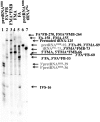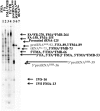Avatar pre-tRNAs help elucidate the properties of tRNA-splicing endonucleases that produce tRNA from permuted genes
- PMID: 23236183
- PMCID: PMC3535657
- DOI: 10.1073/pnas.1219336110
Avatar pre-tRNAs help elucidate the properties of tRNA-splicing endonucleases that produce tRNA from permuted genes
Abstract
Unusual tRNA genes, found in some algae, have their mature terminal 3' portion in front of their 5' portion in the genome. The transcripts from such genes must be cleaved by a pre-tRNA endonuclease to form a functional tRNA. We present a mechanism for the generation of "corrected" tRNAs from such a "permuted" pre-tRNA configuration. We used two avatar (av) or model pre-tRNAs and two splicing endonucleases with distinct mechanisms of recognition of the pre-tRNA. The splicing results are compatible with an evolutionary route in which permuted genes result from a duplication event followed by DNA rearrangement. The model pre-tRNAs permit description of the features that a transcript, derived from a rearranged duplicated gene, must have to give rise to functional tRNA. The two tRNA endonucleases are a eukaryal enzyme that normally acts in a mature domain-dependent mode and an archaeal enzyme that acts in a mature domain-independent mode. Both av pre-tRNAs are able to fold into two conformations: 1 and 2. We find that only conformation 2 can yield a corrected functional tRNA. This result is consistent with contemporary algae representing snapshots of different evolutionary stages, with duplicated genes preceding recombinatorial events generating a permutated gene. In a scenario elucidated by the use of the av pre-tRNAs, algal permuted tRNA genes could have further lost one of two mature domains, eliminating steric problems for the algal tRNA endonuclease, which remains a typical eukaryal enzyme capable of correcting the permuted transcript to a functional tRNA.
Conflict of interest statement
The authors declare no conflict of interest.
Figures




References
-
- Randau L, Pearson M, Söll D. The complete set of tRNA species in Nanoarchaeum equitans. FEBS Lett. 2005;579(13):2945–2947. - PubMed
-
- Randau L, Münch R, Hohn MJ, Jahn D, Söll D. Nanoarchaeum equitans creates functional tRNAs from separate genes for their 5′- and 3′-halves. Nature. 2005;433(7025):537–541. - PubMed
-
- Soma A, et al. Permuted tRNA genes expressed via a circular RNA intermediate in Cyanidioschyzon merolae. Science. 2007;318(5849):450–453. - PubMed
Publication types
MeSH terms
Substances
LinkOut - more resources
Full Text Sources
Medical

